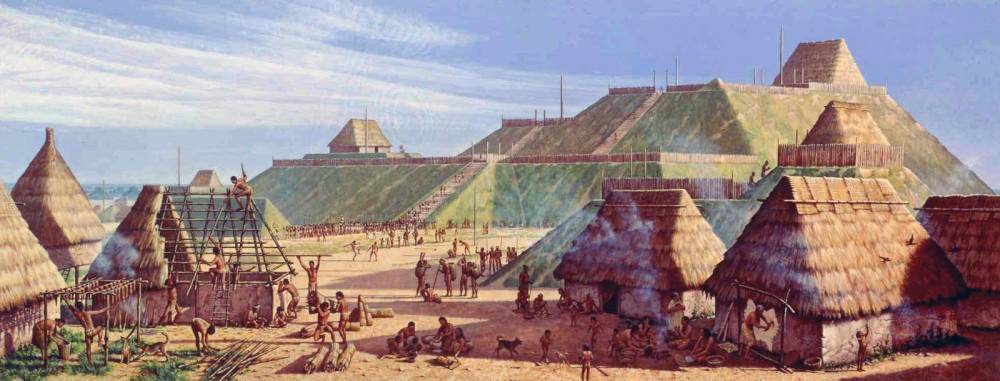
Cahokia, as it may have appeared around 1150 CE. Painting by Michael Hampshire for the Cahokia Mounds State Historic Site.
*The American Yawp is an evolving, collaborative text. Please click here to improve this chapter.*
I. Introduction
Europeans called the Americas “the New World.” But for the millions of Native Americans they encountered, it was anything but. Humans have lived in the Americas for over ten thousand years. Dynamic and diverse, they spoke hundreds of languages and created thousands of distinct cultures. Native Americans built settled communities and followed seasonal migration patterns, maintained peace through alliances and warred with their neighbors, and developed self-sufficient economies and maintained vast trade networks. They cultivated distinct art forms and spiritual values. Kinship ties knit their communities together. But the arrival of Europeans and the resulting global exchange of people, animals, plants, and microbes—what scholars benignly call the Columbian Exchange—bridged more than ten thousand years of geographic separation, inaugurated centuries of violence, unleashed the greatest biological terror the world had ever seen, and revolutionized the history of the world. It began one of the most consequential developments in all of human history and the first chapter in the long American yawp.
II. The First Americans
American history begins with the first Americans. But where do their stories start? Native Americans passed stories down through the millennia that tell of their creation and reveal the contours of Indigenous belief. The Salinan people of present-day California, for example, tell of a bald eagle that formed the first man out of clay and the first woman out of a feather.1 According to a Lenape tradition, the earth was made when Sky Woman fell into a watery world and, with the help of muskrat and beaver, landed safely on a turtle’s back, thus creating Turtle Island, or North America. A Choctaw tradition locates southeastern peoples’ beginnings inside the great Mother Mound earthwork, Nunih Waya, in the lower Mississippi Valley.2 Nahua people trace their beginnings to the place of the Seven Caves, from which their ancestors emerged before they migrated to what is now central Mexico.3 America’s Indigenous peoples have passed down many accounts of their origins, written and oral, which share creation and migration histories.
Archaeologists and anthropologists, meanwhile, focus on migration histories. Studying artifacts, bones, and genetic signatures, these scholars have pieced together a narrative that claims that the Americas were once a “new world” for Native Americans as well.
The last global ice age trapped much of the world’s water in enormous continental glaciers. Twenty thousand years ago, ice sheets, some a mile thick, extended across North America as far south as modern-day Illinois. With so much of the world’s water captured in these massive ice sheets, global sea levels were much lower, and a land bridge connected Asia and North America across the Bering Strait. Between twelve and twenty thousand years ago, Native ancestors crossed the ice, waters, and exposed lands between the continents of Asia and America. These mobile hunter-gatherers traveled in small bands, exploiting vegetable, animal, and marine resources into the Beringian tundra at the northwestern edge of North America. DNA evidence suggests that these ancestors paused—for perhaps fifteen thousand years—in the expansive region between Asia and America.4 Other ancestors crossed the seas and voyaged along the Pacific coast, traveling along riverways and settling where local ecosystems permitted.5 Glacial sheets receded around fourteen thousand years ago, opening a corridor to warmer climates and new resources. Some ancestral communities migrated southward and eastward. Evidence found at Monte Verde, a site in modern-day Chile, suggests that human activity began there at least 14,500 years ago. Similar evidence hints at human settlement in the Florida panhandle and in Central Texas at the same time.6 On many points, archaeological and traditional knowledge sources converge: the dental, archaeological, linguistic, oral, ecological, and genetic evidence illustrates a great deal of diversity, with numerous groups settling and migrating over thousands of years, potentially from many different points of origin.7 Whether emerging from the earth, water, or sky; being made by a creator; or migrating to their homelands, modern Native American communities recount histories in America that date long before human memory.
In the Northwest, Native groups exploited the great salmon-filled rivers. On the plains and prairie lands, hunting communities followed bison herds and moved according to seasonal patterns. In mountains, prairies, deserts, and forests, the cultures and ways of life of paleo-era ancestors were as varied as the geography. These groups spoke hundreds of languages and adopted distinct cultural practices. Rich and diverse diets fueled massive population growth across the continent.
Agriculture arose sometime between nine thousand and five thousand years ago, almost simultaneously in the Eastern and Western Hemispheres. Mesoamericans in modern-day Mexico and Central America relied on domesticated maize (corn) to develop the hemisphere’s first settled population around 1200 BCE.8 Corn was high in caloric content, easily dried and stored, and, in Mesoamerica’s warm and fertile Gulf Coast, could sometimes be harvested twice in a year. Corn—as well as other Mesoamerican crops—spread across North America and continues to hold an important spiritual and cultural place in many Native communities.
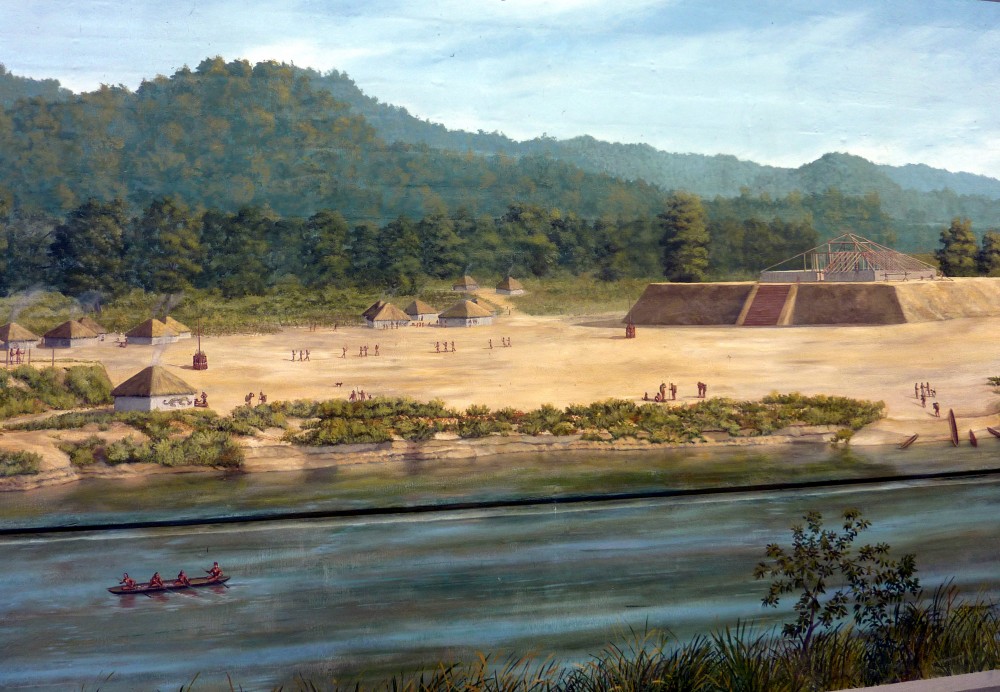
Prehistoric Settlement in Warren County, Mississippi. Mural by Robert Dafford, depicting the Kings Crossing archaeological site as it may have appeared in 1000 CE. Vicksburg Riverfront Murals.
Agriculture flourished in the fertile river valleys between the Mississippi River and the Atlantic Ocean, an area known as the Eastern Woodlands. There, three crops in particular—corn, beans, and squash, known as the Three Sisters—provided nutritional needs necessary to sustain cities and civilizations. In Woodland areas from the Great Lakes and the Mississippi River to the Atlantic coast, Native communities managed their forest resources by burning underbrush to create vast parklike hunting grounds and to clear the ground for planting the Three Sisters. Many groups used shifting cultivation, in which farmers cut the forest, burned the undergrowth, and then planted seeds in the nutrient-rich ashes. When crop yields began to decline, farmers moved to another field and allowed the land to recover and the forest to regrow before again cutting the forest, burning the undergrowth, and restarting the cycle. This technique was particularly useful in areas with difficult soil. In the fertile regions of the Eastern Woodlands, Native American farmers engaged in permanent, intensive agriculture using hand tools. The rich soil and use of hand tools enabled effective and sustainable farming practices, producing high yields without overburdening the soil.9 Typically in Woodland communities, women practiced agriculture while men hunted and fished.
Agriculture allowed for dramatic social change, but for some, it also may have accompanied a decline in health. Analysis of remains reveals that societies transitioning to agriculture often experienced weaker bones and teeth.10 But despite these possible declines, agriculture brought important benefits. Farmers could produce more food than hunters, enabling some members of the community to pursue other skills. Religious leaders, skilled soldiers, and artists could devote their energy to activities other than food production.
North America’s Indigenous peoples shared some broad traits. Spiritual practices, understandings of property, and kinship networks differed markedly from European arrangements. Most Native Americans did not neatly distinguish between the natural and the supernatural. Spiritual power permeated their world and was both tangible and accessible. It could be appealed to and harnessed. Kinship bound most Native North American people together. Most people lived in small communities tied by kinship networks. Many Native cultures understood ancestry as matrilineal: family and clan identity proceeded along the female line, through mothers and daughters, rather than fathers and sons. Fathers, for instance, often joined mothers’ extended families, and sometimes even a mother’s brothers took a more direct role in child-raising than biological fathers. Therefore, mothers often wielded enormous influence at local levels, and men’s identities and influence often depended on their relationships to women. Native American culture, meanwhile, generally afforded greater sexual and marital freedom than European cultures.11 Women, for instance, often chose their husbands, and divorce often was a relatively simple and straightforward process. Moreover, most Native peoples’ notions of property rights differed markedly from those of Europeans. Native Americans generally felt a personal ownership of tools, weapons, or other items that were actively used, and this same rule applied to land and crops. Groups and individuals exploited particular pieces of land and used violence or negotiation to exclude others. But the right to the use of land did not imply the right to its permanent possession.
Native Americans had many ways of communicating, including graphic ones, and some of these artistic and communicative technologies are still used today. For example, Algonquian-speaking Ojibwes used birch-bark scrolls to record medical treatments, recipes, songs, stories, and more. Other Eastern Woodland peoples wove plant fibers, embroidered skins with porcupine quills, and modeled the earth to make sites of complex ceremonial meaning. On the Plains, artisans wove buffalo hair and painted on buffalo skins; in the Pacific Northwest, after the arrival of Europeans, weavers wove goat hair into soft textiles with particular patterns. Maya, Zapotec, and Nahua ancestors in Mesoamerica painted their histories on plant-derived textiles and carved them into stone. In the Andes, Inca recorders noted information in the form of knotted strings, or khipu.12
Two thousand years ago, some of the largest culture groups in North America were the Puebloan groups, centered in the current-day Greater Southwest (the southwestern United States and northwestern Mexico), the Mississippian groups located along the Great River and its tributaries, and the Mesoamerican groups of the areas now known as central Mexico and the Yucatán. Previous developments in agricultural technology enabled the explosive growth of the large early societies, such as that at Tenochtitlán in the Valley of Mexico, Cahokia along the Mississippi River, and in the desert oasis areas of the Greater Southwest.
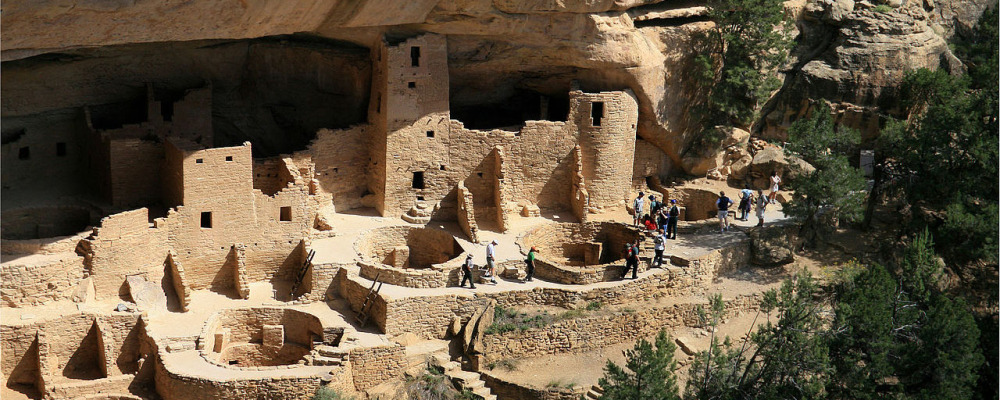
Native peoples in the Southwest began constructing these highly defensible cliff dwellings in 1190 CE and continued expanding and refurbishing them until 1260 CE before abandoning them around 1300 CE. Andreas F. Borchert, Mesa Verde National Park Cliff Palace. Wikimedia. Creative Commons Attribution-Share Alike 3.0 Germany.
Chaco Canyon in northern New Mexico was home to ancestral Puebloan peoples between 900 and 1300 CE. As many as fifteen thousand individuals lived in the Chaco Canyon complex in present-day New Mexico.13 Sophisticated agricultural practices, extensive trading networks, and even the domestication of animals like turkeys allowed the population to swell. Massive residential structures, built from sandstone blocks and lumber carried across great distances, housed hundreds of Puebloan people. One building, Pueblo Bonito, stretched over two acres and rose five stories. Its six hundred rooms were decorated with copper bells, turquoise decorations, and bright macaws.14 Homes like those at Pueblo Bonito included a small dugout room, or kiva, which played an important role in a variety of ceremonies and served as an important center for Puebloan life and culture. Puebloan spirituality was tied both to the earth and the heavens, as generations carefully charted the stars and designed homes in line with the path of the sun and moon.15
The Puebloan people of Chaco Canyon faced several ecological challenges, including deforestation and overirrigation, which ultimately caused the community to collapse and its people to disperse to smaller settlements. An extreme fifty-year drought began in 1130. Shortly thereafter, Chaco Canyon was deserted. New groups, including the Apache and Navajo, entered the vacated territory and adopted several Puebloan customs. The same drought that plagued the Pueblo also likely affected the Mississippian peoples of the American Midwest and South. The Mississippians developed one of the largest civilizations north of modern-day Mexico. Roughly one thousand years ago, the largest Mississippian settlement, Cahokia, located just east of modern-day St. Louis, peaked at a population of between ten thousand and thirty thousand. It rivaled contemporary European cities in size. No city north of modern Mexico, in fact, would match Cahokia’s peak population levels until after the American Revolution. The city itself spanned two thousand acres and centered on Monks Mound, a large earthen hill that rose ten stories and was larger at its base than the pyramids of Egypt. As with many of the peoples who lived in the Woodlands, life and death in Cahokia were linked to the movement of the stars, sun, and moon, and their ceremonial earthwork structures reflect these important structuring forces.
Cahokia was politically organized around chiefdoms, a hierarchical, clan-based system that gave leaders both secular and sacred authority. The size of the city and the extent of its influence suggest that the city relied on a number of lesser chiefdoms under the authority of a paramount leader. Social stratification was partly preserved through frequent warfare. War captives were enslaved, and these captives formed an important part of the economy in the North American Southeast. Native American slavery was not based on holding people as property. Instead, Native Americans understood the enslaved as people who lacked kinship networks. Slavery, then, was not always a permanent condition. Very often, a formerly enslaved person could become a fully integrated member of the community. Adoption or marriage could enable an enslaved person to enter a kinship network and join the community. Slavery and captive trading became an important way that many Native communities regrew and gained or maintained power.
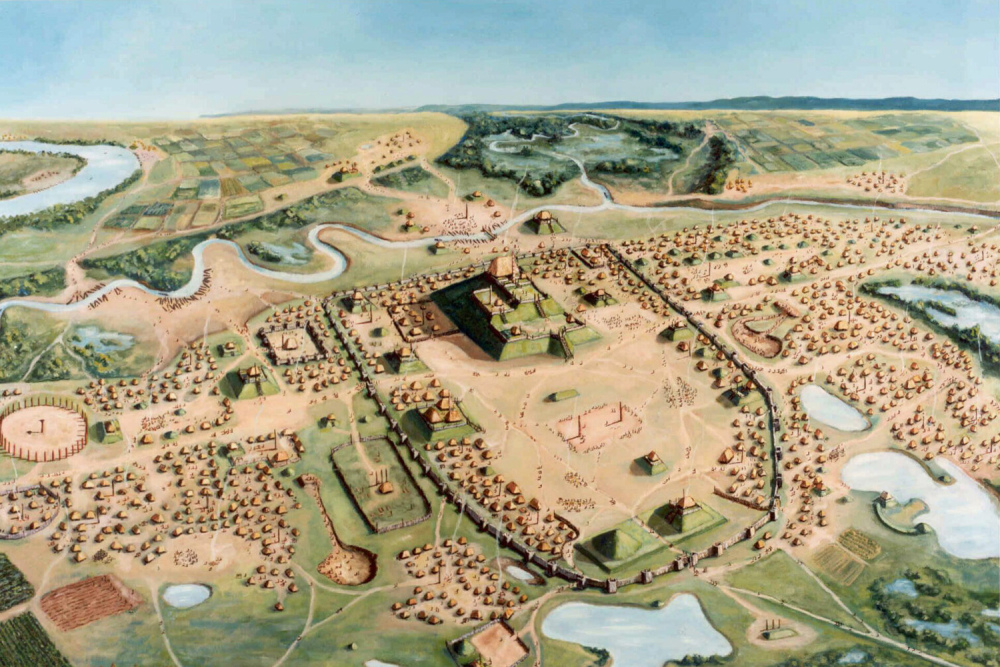
An artist’s rendering of Cahokia as it may have appeared in 1150 CE. Prepared by Bill Isminger and Mark Esarey with artwork by Greg Harlin. From the Cahokia Mounds State Historic Site.
Around 1050, Cahokia experienced what one archaeologist has called a “big bang,” which included “a virtually instantaneous and pervasive shift in all things political, social, and ideological.”16 The population grew almost 500 percent in only one generation, and new people groups were absorbed into the city and its supporting communities. By 1300, the once-powerful city had undergone a series of strains that led to collapse. Scholars previously pointed to ecological disaster or slow depopulation through emigration, but new research instead emphasizes mounting warfare, or internal political tensions. Environmental explanations suggest that population growth placed too great a burden on the arable land. Others suggest that the demand for fuel and building materials led to deforestation, erosion, and perhaps an extended drought. Recent evidence, including defensive stockades, suggests that political turmoil among the ruling elite and threats from external enemies may explain the end of the once-great civilization.17
North American communities were connected by kin, politics, and culture and sustained by long-distance trading routes. The Mississippi River served as an important trade artery, but all of the continent’s waterways were vital to transportation and communication. Cahokia became a key trading center partly because of its position near the Mississippi, Illinois, and Missouri Rivers. These rivers created networks that stretched from the Great Lakes to the American Southeast. Archaeologists can identify materials, like seashells, that traveled over a thousand miles to reach the center of this civilization. At least 3,500 years ago, the community at what is now Poverty Point, Louisiana, had access to copper from present-day Canada and flint from modern-day Indiana. Sheets of mica found at the sacred Serpent Mound site near the Ohio River came from the Allegheny Mountains, and obsidian from nearby earthworks came from Mexico. Turquoise from the Greater Southwest was used at Teotihuacan 1200 years ago.
In the Eastern Woodlands, many Native American societies lived in smaller, dispersed communities to take advantage of rich soils and abundant rivers and streams. The Lenapes, also known as Delawares, farmed the bottomlands throughout the Hudson and Delaware River watersheds in New York, Pennsylvania, New Jersey, and Delaware. Their hundreds of settlements, stretching from southern Massachusetts through Delaware, were loosely bound together by political, social, and spiritual connections.
Dispersed and relatively independent, Lenape communities were bound together by oral histories, ceremonial traditions, consensus-based political organization, kinship networks, and a shared clan system. Kinship tied the various Lenape communities and clans together, and society was organized along matrilineal lines. Marriage occurred between clans, and a married man joined the clan of his wife. Lenape women wielded authority over marriages, households, and agricultural production and may even have played a significant part in determining the selection of leaders, called sachems. Dispersed authority, small settlements, and kin-based organization contributed to the long-lasting stability and resilience of Lenape communities.18 One or more sachems governed Lenape communities by the consent of their people. Lenape sachems acquired their authority by demonstrating wisdom and experience. This differed from the hierarchical organization of many Mississippian cultures. Large gatherings did exist, however, as dispersed communities and their leaders gathered for ceremonial purposes or to make big decisions. Sachems spoke for their people in larger councils that included men, women, and elders. The Lenapes experienced occasional tensions with other Indigenous groups like the Iroquois to the north or the Susquehannock to the south, but the lack of defensive fortifications near Lenape communities convinced archaeologists that the Lenapes avoided large-scale warfare.
The continued longevity of Lenape societies, which began centuries before European contact, was also due to their skills as farmers and fishers. Along with the Three Sisters, Lenape women planted tobacco, sunflowers, and gourds. They harvested fruits and nuts from trees and cultivated numerous medicinal plants, which they used with great proficiency. The Lenapes organized their communities to take advantage of growing seasons and the migration patterns of animals and fowl that were a part of their diet. During planting and harvesting seasons, Lenapes gathered in larger groups to coordinate their labor and take advantage of local abundance. As proficient fishers, they organized seasonal fish camps to net shellfish and catch shad. Lenapes wove nets, baskets, mats, and a variety of household materials from the rushes found along the streams, rivers, and coasts. They made their homes in some of the most fertile and abundant lands in the Eastern Woodlands and used their skills to create a stable and prosperous civilization. The first Dutch and Swedish settlers who encountered the Lenapes in the seventeenth century recognized Lenape prosperity and quickly sought their friendship. Their lives came to depend on it.
In the Pacific Northwest, the Kwakwaka’wakw, Tlingits, Haidas, and hundreds of other peoples, speaking dozens of languages, thrived in a land with a moderate climate, lush forests, and many rivers. The peoples of this region depended on salmon for survival and valued it accordingly. Images of salmon decorated totem poles, baskets, canoes, oars, and other tools. The fish was treated with spiritual respect and its image represented prosperity, life, and renewal. Sustainable harvesting practices ensured the survival of salmon populations. The Coast Salish people and several others celebrated the First Salmon Ceremony when the first migrating salmon was spotted each season. Elders closely observed the size of the salmon run and delayed harvesting to ensure that a sufficient number survived to spawn and return in the future.19 Men commonly used nets, hooks, and other small tools to capture salmon as they migrated upriver to spawn. Massive cedar canoes, as long as fifty feet and carrying as many as twenty men, also enabled extensive fishing expeditions in the Pacific Ocean, where skilled fishermen caught halibut, sturgeon, and other fish, sometimes hauling thousands of pounds in a single canoe.20
Food surpluses enabled significant population growth, and the Pacific Northwest became one of the most densely populated regions of North America. The combination of population density and surplus food created a unique social organization centered on elaborate feasts, called potlatches. These potlatches celebrated births and weddings and determined social status. The party lasted for days and hosts demonstrated their wealth and power by entertaining guests with food, artwork, and performances. The more the hosts gave away, the more prestige and power they had within the group. Some men saved for decades to host an extravagant potlatch that would in turn give him greater respect and power within the community.
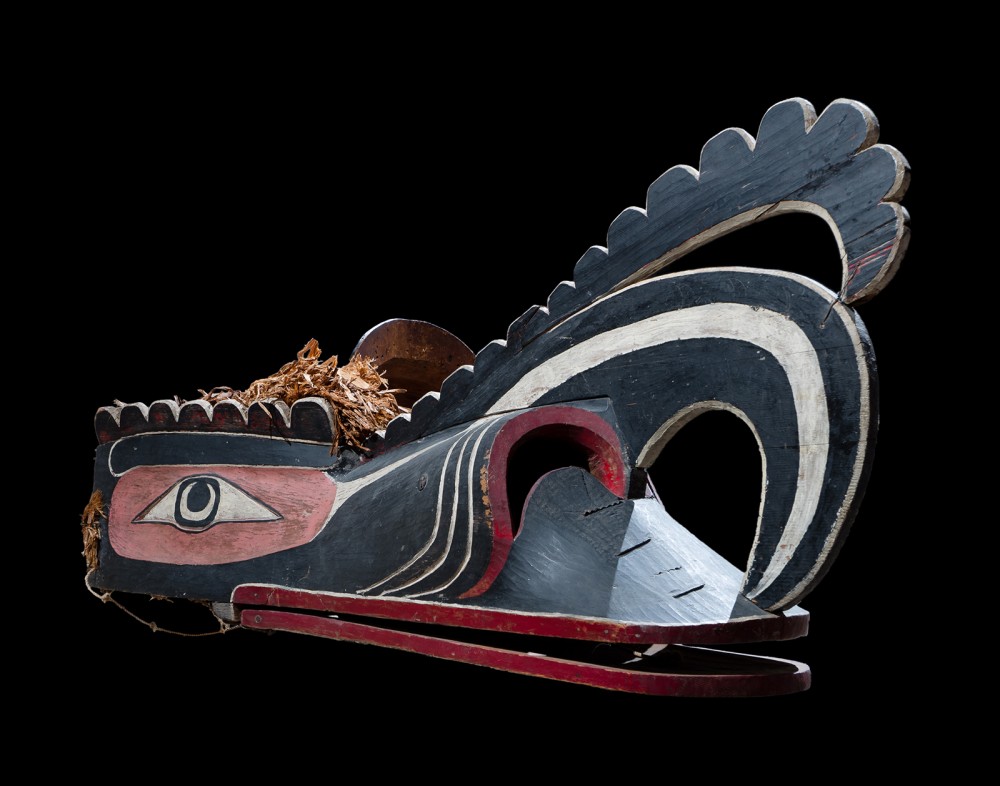
Intricately carved masks, like the Crooked Beak of Heaven Mask, used natural elements such as animals to represent supernatural forces during ceremonial dances and festivals. Nineteenth-century crooked beak of heaven mask from the Kwakwaka’wakw. Wikimedia. Creative Commons Attribution 3.0 Unported.
Many peoples of the Pacific Northwest built elaborate plank houses out of the region’s abundant cedar trees. The five-hundred-foot-long Suquamish Oleman House (or Old Man House), for instance, rested on the banks of Puget Sound.21 Giant cedar trees were also carved and painted in the shape of animals or other figures to tell stories and express identities. These totem poles became the most recognizable artistic form of the Pacific Northwest, but people also carved masks and other wooden items, such as hand drums and rattles, out of the region’s great trees.
Despite commonalities, Native cultures varied greatly. The New World was marked by diversity and contrast. By the time Europeans were poised to cross the Atlantic, Native Americans spoke hundreds of languages and lived in keeping with the hemisphere’s many climates. Some lived in cities, others in small bands. Some migrated seasonally; others settled permanently. All Native peoples had long histories and well-formed, unique cultures that developed over millennia. But the arrival of Europeans changed everything.
III. European Expansion
Scandinavian seafarers reached the New World long before Columbus. At their peak they sailed as far east as Constantinople and raided settlements as far south as North Africa. They established limited colonies in Iceland and Greenland and, around the year 1000, Leif Erikson reached Newfoundland in present-day Canada. But the Norse colony failed. Culturally and geographically isolated, the Norse were driven back to the sea by some combination of limited resources, inhospitable weather, food shortages, and Native resistance.
Then, centuries before Columbus, the Crusades linked Europe with the wealth, power, and knowledge of Asia. Europeans rediscovered or adopted Greek, Roman, and Muslim knowledge. The hemispheric dissemination of goods and knowledge not only sparked the Renaissance but fueled long-term European expansion. Asian goods flooded European markets, creating a demand for new commodities. This trade created vast new wealth, and Europeans battled one another for trade supremacy.
European nation-states consolidated under the authority of powerful kings. A series of military conflicts between England and France—the Hundred Years’ War—accelerated nationalism and cultivated the financial and military administration necessary to maintain nation-states. In Spain, the marriage of Ferdinand of Aragon and Isabella of Castile consolidated the two most powerful kingdoms of the Iberian peninsula. The Crusades had never ended in Iberia: the Spanish crown concluded centuries of intermittent warfare—the Reconquista—by expelling Muslim Moors and Iberian Jews from the Iberian peninsula in 1492, just as Christopher Columbus sailed west. With new power, these new nations—and their newly empowered monarchs—yearned to access the wealth of Asia.
Seafaring Italian traders commanded the Mediterranean and controlled trade with Asia. Spain and Portugal, at the edges of Europe, relied on middlemen and paid higher prices for Asian goods. They sought a more direct route. And so they looked to the Atlantic. Portugal invested heavily in exploration. From his estate on the Sagres Peninsula of Portugal, a rich sailing port, Prince Henry the Navigator (Infante Henry, Duke of Viseu) invested in research and technology and underwrote many technological breakthroughs. His investments bore fruit. In the fifteenth century, Portuguese sailors perfected the astrolabe, a tool to calculate latitude, and the caravel, a ship well suited for ocean exploration. Both were technological breakthroughs. The astrolabe allowed for precise navigation, and the caravel, unlike more common vessels designed for trading on the relatively placid Mediterranean, was a rugged ship with a deep draft capable of making lengthy voyages on the open ocean and, equally important, carrying large amounts of cargo while doing so.
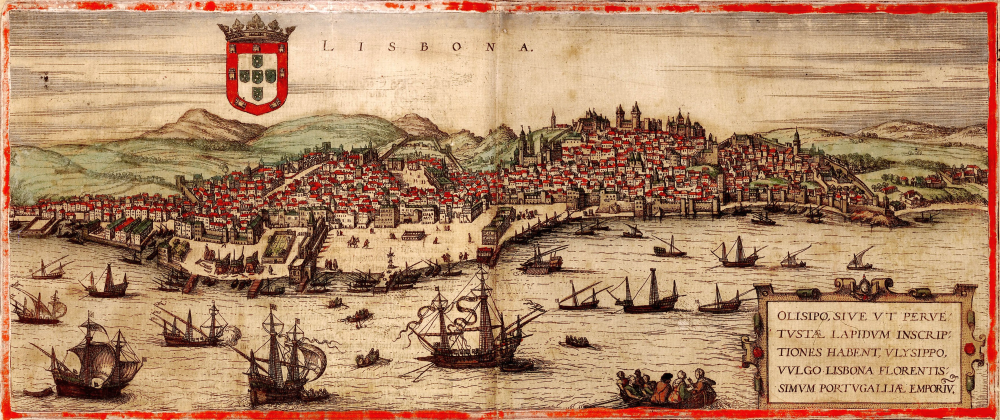
Engraving of sixteenth-century Lisbon from Civitatis Orbis Terrarum, “The Cities of the World,” ed. Georg Braun (Cologne: 1572). Wikimedia.
Blending economic and religious motivations, the Portuguese established forts along the Atlantic coast of Africa during the fifteenth century, inaugurating centuries of European colonization there. Portuguese trading posts generated new profits that funded further trade and further colonization. Trading posts spread across the vast coastline of Africa, and by the end of the fifteenth century, Vasco da Gama leapfrogged his way around the coasts of Africa to reach India and other lucrative Asian markets.
The vagaries of ocean currents and the limits of contemporary technology forced Iberian sailors to sail west into the open sea before cutting back east to Africa. So doing, the Spanish and Portuguese stumbled on several islands off the coast of Europe and Africa, including the Azores, the Canary Islands, and the Cape Verde Islands. They became training grounds for the later colonization of the Americas and saw the first large-scale cultivation of sugar by enslaved laborers.
Sugar was originally grown in Asia but became a popular, widely profitable luxury item consumed by the nobility of Europe. The Portuguese learned the sugar-growing process from Mediterranean plantations started by Muslims, using imported enslaved labor from southern Russia and Islamic countries. Sugar was a difficult crop. It required tropical temperatures, daily rainfall, unique soil conditions, and a fourteen-month growing season. But on the newly discovered, mostly uninhabited Atlantic islands, the Portuguese had found new, defensible land to support sugar production. New patterns of human and ecological destruction followed. Isolated from the mainlands of Europe and Africa for millennia, Canary Island natives—known as the Guanches—were enslaved or perished soon after Europeans arrived. This demographic disaster presaged the demographic results for the Native American populations upon the arrival of the Spanish.
Portugal’s would-be planters needed workers to cultivate the difficult, labor-intensive crop. They first turned to the trade relationships that Portuguese merchants established with African city-states in Senegambia, along the Gold Coast, as well as the kingdoms of Benin, Kongo, and Ndongo.22 The Portuguese turned to enslaved Africans from the mainland as a labor source for these island plantations. At the beginning of this Euroafrican slave-trading system, African leaders traded war captives—who by custom forfeited their freedom if captured during battle—for Portuguese guns, iron, and manufactured goods. It is important to note that slaving in Africa, like slaving among Indigenous Americans, bore little resemblance to the chattel slavery of the antebellum United States.23
From bases along the Atlantic coast, the Portuguese began purchasing enslaved people for export to the Atlantic islands of Madeira, the Canaries, and the Cape Verdes to work the sugar fields. Thus, were born the first great Atlantic plantations. A few decades later, at the end of the 15th century, the Portuguese plantation system developed on the island of São Tomé became a model for the plantation system as it was expanded across the Atlantic.
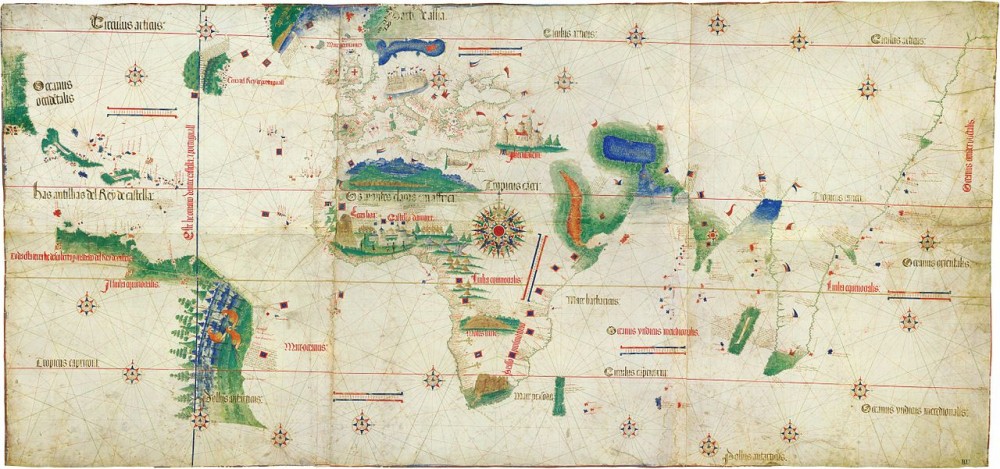
By the fifteenth century, the Portuguese had established forts and colonies on islands and along the rim of the Atlantic Ocean; other major European countries soon followed in step. An anonymous cartographer created this map known as the Cantino Map, the earliest known map of European exploration in the New World, to depict these holdings and argue for the greatness of his native Portugal. Cantino planisphere (1502), Biblioteca Estense, Modena, Italy. Wikimedia.
Spain, too, stood on the cutting edge of maritime technology. Spanish sailors had become masters of the caravels. As Portugal consolidated control over African trading networks and the circuitous eastbound sea route to Asia, Spain yearned for its own path to empire. Christopher Columbus, a skilled Italian-born sailor who had studied under Portuguese navigators, promised just that opportunity.
Educated Asians and Europeans of the fifteenth century knew the world was round. They also knew that while it was therefore technically possible to reach Asia by sailing west from Europe—thereby avoiding Italian or Portuguese middlemen—the earth’s vast size would doom even the greatest caravels to starvation and thirst long before they ever reached their destination. But Columbus underestimated the size of the globe by a full two thirds and therefore believed it was possible. After unsuccessfully shopping his proposed expedition in several European courts, he convinced Queen Isabella and King Ferdinand of Spain to provide him three small ships, which set sail in 1492. Columbus was both confoundingly wrong about the size of the earth and spectacularly lucky that two large continents lurked in his path. On October 12, 1492, after two months at sea, the Niña, Pinta, and Santa María and their ninety men landed in the modern-day Bahamas.
The Indigenous Arawaks, or Taíno, populated the Caribbean islands. They fished and grew corn, yams, and cassava. Columbus described them as innocents. “They are very gentle and without knowledge of what is evil; nor the sins of murder or theft,” he reported to the Spanish crown. “Your highness may believe that in all the world there can be no better people. . . . They love their neighbors as themselves, and their speech is the sweetest and gentlest in the world, and always with a smile.” But Columbus had come for wealth and he could find little. The Arawaks, however, wore small gold ornaments. Columbus left thirty-nine Spaniards at a military fort on Hispaniola to find and secure the source of the gold while he returned to Spain, with a dozen captured and branded Arawaks. Columbus arrived to great acclaim and quickly worked to outfit a return voyage. Spain’s New World motives were clear from the beginning. If outfitted for a return voyage, Columbus promised the Spanish crown gold and enslaved laborers. Columbus reported, “With fifty men they can all be subjugated and made to do what is required of them.”24
Columbus was outfitted with seventeen ships and over one thousand men to return to the West Indies (Columbus made four voyages to the New World). Still believing he had landed in the East Indies, he promised to reward Isabella and Ferdinand’s investment. But when material wealth proved slow in coming, the Spanish embarked on a vicious campaign to extract every possible ounce of wealth from the Caribbean. The Spanish decimated the Arawaks. Bartolomé de Las Casas traveled to the New World in 1502 and later wrote, “I saw with these Eyes of mine the Spaniards for no other reason, but only to gratify their bloody mindedness, cut off the Hands, Noses, and Ears, both of Indians and Indianesses.”25 When the enslaved laborers exhausted the islands’ meager gold reserves, the Spaniards forced them to labor on their huge new estates, the encomiendas. Las Casas described European barbarities in cruel detail. By presuming the natives had no humanity, the Spaniards utterly abandoned theirs. Casual violence and dehumanizing exploitation ravaged the Arawaks. The Indigenous population collapsed. Within a few generations the whole island of Hispaniola had been depopulated and a whole people exterminated. Historians’ estimates of the island’s pre-contact population range from fewer than one million to as many as eight million (Las Casas estimated it at three million). In a few short years, they were gone. “Who in future generations will believe this?” Las Casas wondered. “I myself writing it as a knowledgeable eyewitness can hardly believe it.”
Despite the diversity of Native populations and the existence of several strong empires, Native Americans were wholly unprepared for the arrival of Europeans. Biology magnified European cruelties. Cut off from the Old World, its domesticated animals, and its immunological history, Native Americans lived free from the terrible diseases that ravaged populations in Asia, Europe and Africa. But their blessing now became a curse. Native Americans lacked the immunities that Europeans and Africans had developed over centuries of deadly epidemics, and so when Europeans arrived, carrying smallpox, typhus, influenza, diphtheria, measles, and hepatitis, plagues decimated Native communities.26 Many died in war and slavery, but millions died in epidemics. All told, in fact, some scholars estimate that as much as 90 percent of the population of the Americas perished within the first century and a half of European contact.27
Though ravaged by disease and warfare, Native Americans forged middle grounds, resisted with violence, accommodated and adapted to the challenges of colonialism, and continued to shape the patterns of life throughout the New World for hundreds of years. But the Europeans kept coming.
IV. Spanish Exploration and Conquest
As news of the Spanish conquest spread, wealth-hungry Spaniards poured into the New World seeking land, gold, and titles. A New World empire spread from Spain’s Caribbean foothold. Motives were plain: said one soldier, “we came here to serve God and the king, and also to get rich.”28 Mercenaries joined the conquest and raced to capture the human and material wealth of the New World.
The Spanish managed labor relations through a legal system known as the encomienda, an exploitive feudal arrangement in which Spain tied Indigenous laborers to vast estates. In the encomienda, the Spanish crown granted a person not only land but a specified number of natives as well. Encomenderos brutalized their laborers. After Bartolomé de Las Casas published his incendiary account of Spanish abuses (The Destruction of the Indies), Spanish authorities abolished the encomienda in 1542 and replaced it with the repartimiento. Intended as a milder system, the repartimiento nevertheless replicated many of the abuses of the older system, and the rapacious exploitation of the Native population continued as Spain spread its empire over the Americas.
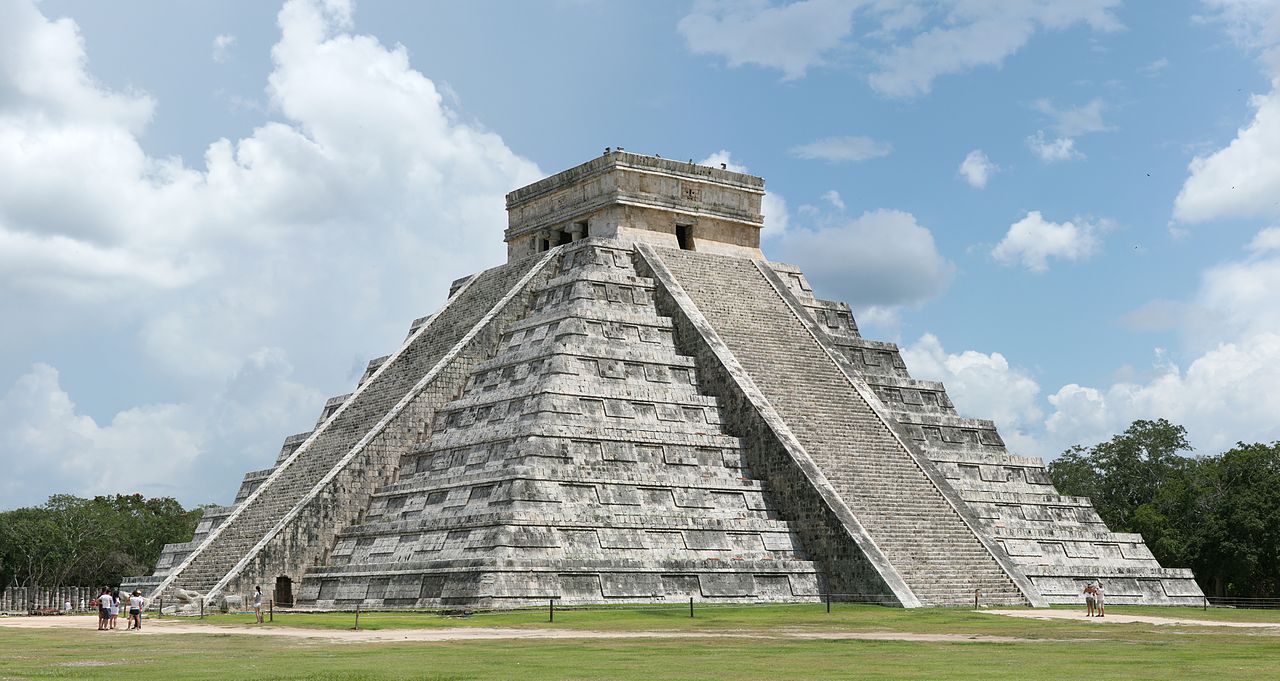
El Castillo (pyramid of Kukulcán) in Chichén Itzá. Photograph by Daniel Schwen. Wikimedia. Creative Commons Attribution-Share Alike 4.0 International.
As Spain’s New World empire expanded, Spanish conquerors met the massive empires of Central and South America, civilizations that dwarfed anything found in North America. In Central America the Maya built massive temples, sustained large populations, and constructed a complex and long-lasting civilization with a written language, advanced mathematics, and stunningly accurate calendars. But Maya civilization, although it had not disappeared, nevertheless collapsed before European arrival, likely because of droughts and unsustainable agricultural practices. But the eclipse of the Maya only heralded the later rise of the most powerful Native civilization ever seen in the Western Hemisphere: the Aztecs.
Militaristic migrants from northern Mexico, the Aztecs moved south into the Valley of Mexico, conquered their way to dominance, and built the largest empire in the New World. When the Spaniards arrived in Mexico they found a sprawling civilization centered around Tenochtitlán, an awe-inspiring city built on a series of natural and man-made islands in the middle of Lake Texcoco, located today within modern-day Mexico City. Tenochtitlán, founded in 1325, rivaled the world’s largest cities in size and grandeur.29
Much of the city was fed by crops grown on large artificial islands called chinampas, which the Aztecs constructed by dredging mud and rich sediment from the bottom of the lake and depositing it over time to form new landscapes. A massive pyramid temple, the Templo Mayor, was located at the city center (its ruins can still be found in the center of Mexico City). When the Spaniards arrived, they could scarcely believe what they saw: 70,000 buildings, housing perhaps 200,000–250,000 people, all built on a lake and connected by causeways and canals. Bernal Díaz del Castillo, a Spanish soldier, later recalled, “When we saw so many cities and villages built in the water and other great towns on dry land, we were amazed and said that it was like the enchantments. . . . Some of our soldiers even asked whether the things that we saw were not a dream? . . . I do not know how to describe it, seeing things as we did that had never been heard of or seen before, not even dreamed about.”30
From their island city the Aztecs dominated an enormous swath of central and southern Mesoamerica. They ruled their empire through a decentralized network of subject peoples that paid regular tribute—including everything from the most basic items, such as corn, beans, and other foodstuffs, to luxury goods such as jade, cacao, and gold—and provided troops for the empire. But unrest festered beneath the Aztecs’ imperial power, and European conquerors lusted after its vast wealth.
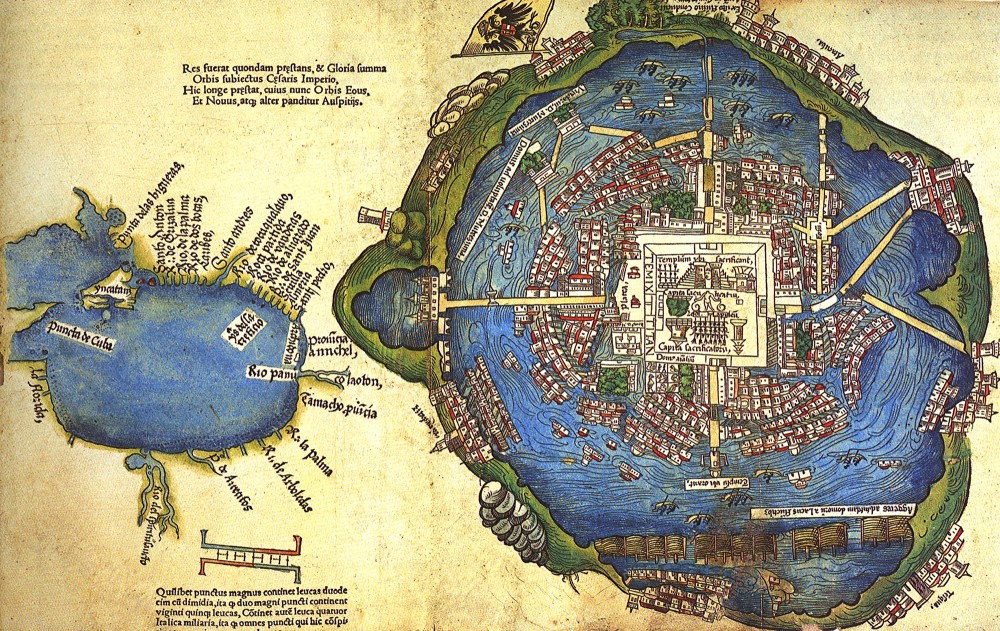
This sixteenth-century map of Tenochtitlan shows the aesthetic beauty and advanced infrastructure of this great Aztec city. Map, c. 1524, Wikimedia.
Hernán Cortés, an ambitious, thirty-four-year-old Spaniard who had won riches in the conquest of Cuba, organized an invasion of Mexico in 1519. Sailing with six hundred men, horses, and cannon, he landed on the coast of Mexico. Relying on a Native translator, whom he called Doña Marina, and whom Mexican folklore denounces as La Malinche, Cortés gathered information and allies in preparation for conquest. Through intrigue, brutality, and the exploitation of endemic political divisions, he enlisted the aid of thousands of Native allies, defeated Spanish rivals, and marched on Tenochtitlán.
Aztec dominance rested on fragile foundations and many of the region’s semi-independent city-states yearned to break from Aztec rule. Nearby kingdoms, including the Tarascans to the north and the remains of Maya city-states on the Yucatán peninsula, chafed at Aztec power.
Through persuasion, the Spaniards entered Tenochtitlán peacefully. Cortés then captured the emperor Montezuma and used him to gain control of the Aztecs’ gold and silver reserves and their network of mines. Eventually, the Aztecs revolted. Montezuma was branded a traitor, and uprising ignited the city. Montezuma was killed along with a third of Cortés’s men in la noche triste, the “night of sorrows.” The Spanish fought through thousands of Indigenous insurgents and across canals to flee the city, where they regrouped, enlisted more Native allies, captured Spanish reinforcements, and, in 1521, besieged the island city. The Spaniards’ eighty-five-day siege cut off food and fresh water. Smallpox ravaged the city. One Spanish observer said it “spread over the people as great destruction. Some it covered on all parts—their faces, their heads, their breasts, and so on. There was great havoc. Very many died of it. . . . They could not move; they could not stir.”31 Cortés, the Spaniards, and their Native allies then sacked the city. The temples were plundered and fifteen thousand died. After two years of conflict, a million-person-strong empire was toppled by disease, dissension, and a thousand European conquerors.
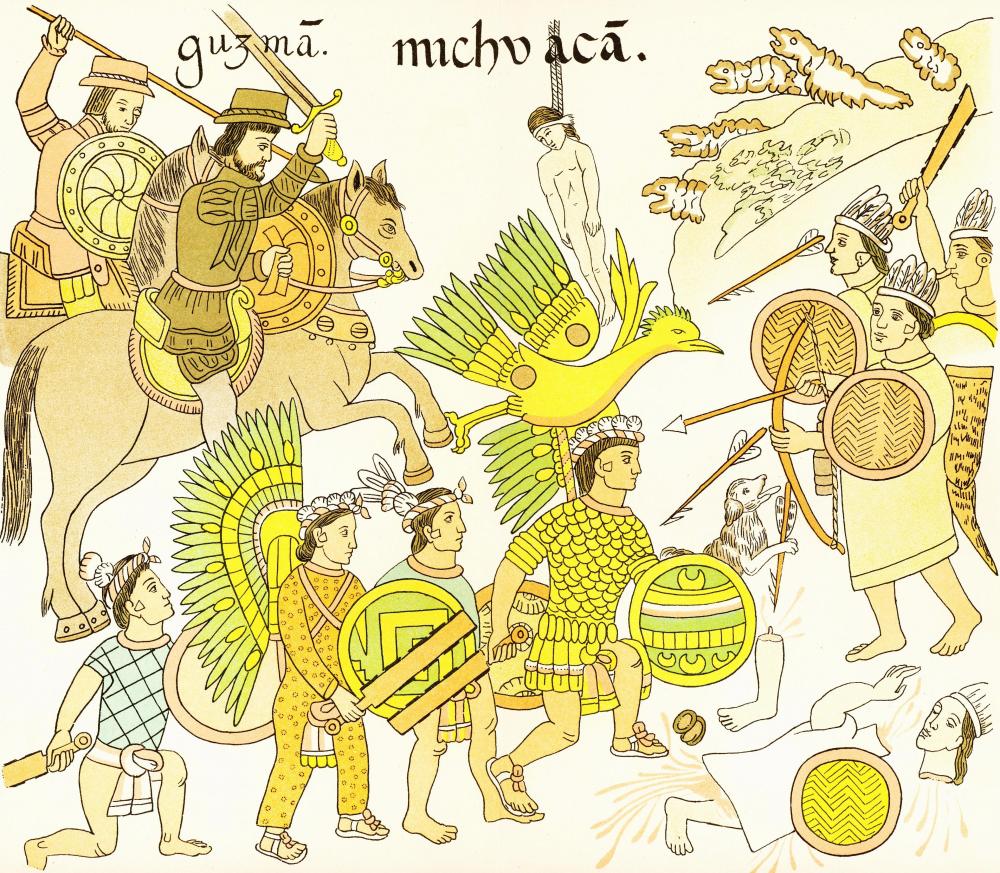
The Spanish relied on Indigenous allies. The Tlaxcala were among the most important Spanish allies in their conquest. This sixteenth-century drawing depicts the Spanish and their Tlaxcalan allies fighting against the Purépecha. Wikimedia.
Farther south, along the Andes Mountains in South America, the Quechuas, or Incas, managed a vast mountain empire. From their capital of Cuzco in the Andean highlands, through conquest and negotiation, the Incas built an empire that stretched around the western half of the South American continent from present day Ecuador to central Chile and Argentina. They cut terraces into the sides of mountains to farm fertile soil, and by the 1400s they managed a thousand miles of Andean roads that tied together perhaps twelve million people. But like the Aztecs, unrest between the Incas and conquered groups created tensions and left the empire vulnerable to invaders. Smallpox spread in advance of Spanish conquerors and hit the Incan empire in 1525. Epidemics ravaged the population, cutting the empire’s population in half and killing the Incan emperor Huayna Capac and many members of his family. A bloody war of succession ensued. Inspired by Cortés’s conquest of Mexico, Francisco Pizarro moved south and found an empire torn by chaos. With 168 men, he deceived Incan rulers, took control of the empire, and seized the capital city, Cuzco, in 1533. Disease, conquest, and slavery ravaged the remnants of the Incan empire.
After the conquests of Mexico and Peru, Spain settled into its new empire. A vast administrative hierarchy governed the new holdings: royal appointees oversaw an enormous territory of landed estates, and Indigenous laborers and administrators regulated the extraction of gold and silver and oversaw their transport across the Atlantic in Spanish galleons. Meanwhile, Spanish migrants poured into the New World. During the sixteenth century alone, 225,000 migrated, and 750,000 came during the entire three centuries of Spanish colonial rule. Spaniards, often single, young, and male, emigrated for the various promises of land, wealth, and social advancement. Laborers, craftsmen, soldiers, clerks, and priests all crossed the Atlantic in large numbers. Indigenous people, however, always outnumbered the Spanish, and the Spaniards, by both necessity and design, incorporated Native Americans into colonial life. This incorporation did not mean equality, however.
An elaborate racial hierarchy marked Spanish life in the New World. Regularized in the mid-1600s but rooted in medieval practices, the Sistema de Castas organized individuals into various racial groups based on their supposed “purity of blood.” Elaborate classifications became almost prerequisites for social and political advancement in Spanish colonial society. Peninsulares—Iberian-born Spaniards, or españoles—occupied the highest levels of administration and acquired the greatest estates. Their descendants, New World-born Spaniards, or criollos, occupied the next rung and rivaled the peninsulares for wealth and opportunity. Mestizos—a term used to describe those of mixed Spanish and Indigenous heritage—followed.
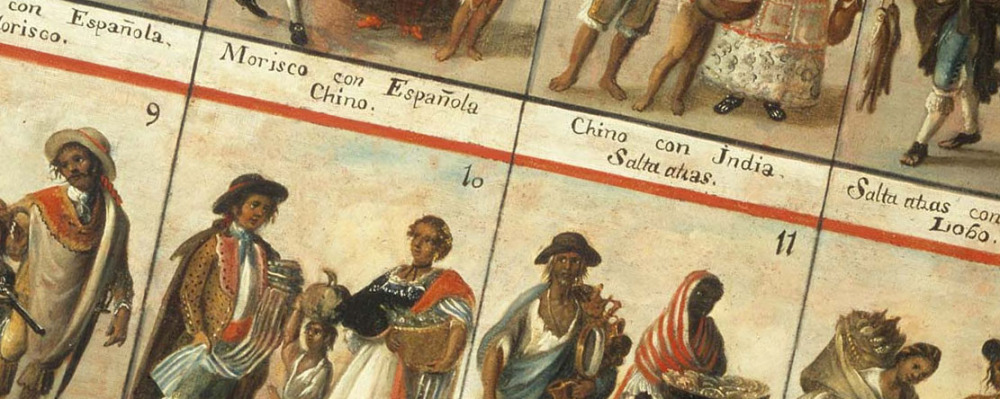
Casta paintings illustrated the varying degrees of intermixture between colonial subjects, defining them for Spanish officials. Unknown artist, Las Castas, Museo Nacional del Virreinato, Tepotzotlan, Mexico. Wikimedia.
Like the French later in North America, the Spanish tolerated and sometimes even supported interracial marriage. There were simply too few Spanish women in the New World to support the natural growth of a purely Spanish population. The Catholic Church endorsed interracial marriage as a moral bulwark against bastardy and rape. By 1600, mestizos made up a large portion of the colonial population.32 By the early 1700s, more than one third of all marriages bridged the Spanish-Indigenous divide. Separated by wealth and influence from the peninsulares and criollos, mestizos typically occupied a middling social position in Spanish New World society. They were not quite Indios, or Indigenous people, but their lack of limpieza de sangre, or “pure blood,” removed them from the privileges of full-blooded Spaniards. Spanish fathers of sufficient wealth and influence might shield their mestizo children from racial prejudice, and a number of wealthy mestizos married españoles to “whiten” their family lines, but more often mestizos were confined to a middle station in the Spanish New World. Enslaved and Indigenous people occupied the lowest rungs of the social ladder.
Many manipulated the Sistema de Castas to gain advantages for themselves and their children. Mestizo mothers, for instance, might insist that their mestizo daughters were actually castizas, or quarter-Indigenous, who, if they married a Spaniard, could, in the eyes of the law, produce “pure” criollo children entitled to the full rights and opportunities of Spanish citizens. But “passing” was an option only for the few. Instead, the massive Native populations within Spain’s New World Empire ensured a level of cultural and racial mixture—or mestizaje—unparalleled in British North America. Spanish North America wrought a hybrid culture that was neither fully Spanish nor fully Indigenous. The Spanish not only built Mexico City atop Tenochtitlán, but food, language, and families were also constructed on Indigenous foundations. In 1531, a poor Indigenous man named Juan Diego reported that he was visited by the Virgin Mary, who came as a dark-skinned Nahuatl-speaking Indigenous woman.33 Reports of miracles spread across Mexico and the Virgen de Guadalupe became a national icon for a new mestizo society.
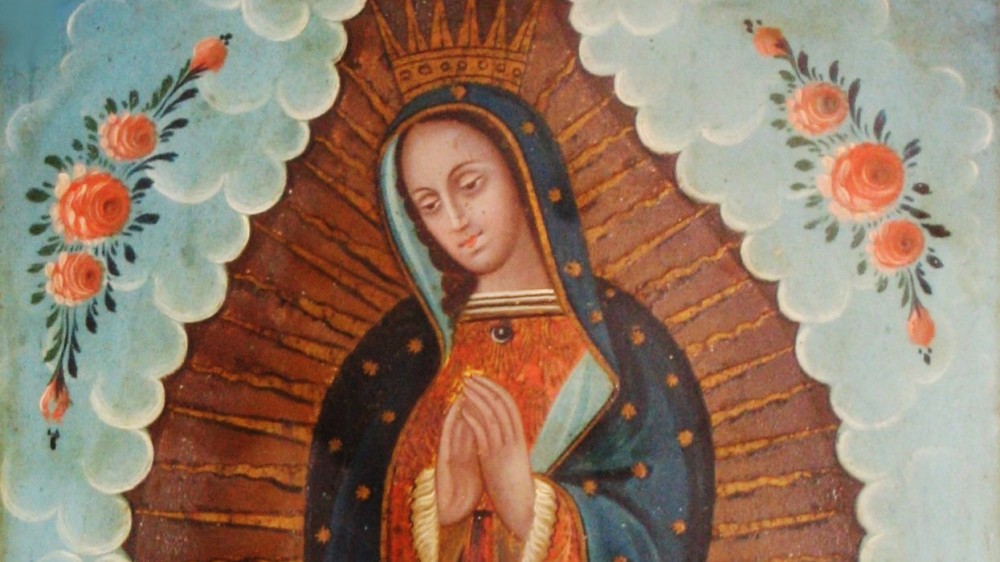
Our Lady of Guadalupe is perhaps the most culturally important and extensively reproduced Mexican-Catholic image. In the iconic depiction, Mary stands atop the tilma (peasant cloak) of Juan Diego, on which according to his story appeared the image of the Virgin of Guadalupe. Throughout Mexican history, the story and image of Our Lady of Guadalupe has been a unifying national symbol. Mexican retablo of Our Lady of Guadalupe, 19th century, in El Paso Museum of Art. Wikimedia.
From Mexico, Spain expanded northward. Lured by the promises of gold and another Tenochtitlán, Spanish expeditions scoured North America for another wealthy Indigenous empire. Huge expeditions, resembling vast moving communities, composed of hundreds of soldiers, settlers, priests, and enslaved people, with enormous numbers of livestock, moved across the continent. Juan Ponce de León, the conqueror of Puerto Rico, landed in Florida in 1513 in search of wealth and enslaved laborers. Álvar Núñez Cabeza de Vaca joined the Narváez expedition to Florida a decade later but was shipwrecked and forced to embark on a remarkable multiyear odyssey along the coast of the Gulf of Mexico and Texas into Mexico. Pedro Menéndez de Avilés founded St. Augustine, Florida, in 1565, and it remains the oldest continuously occupied European settlement in the present-day United States.
But without the rich gold and silver mines of Mexico, the plantation-friendly climate of the Caribbean, or the exploitive potential of large Indigenous empires, North America offered little incentive for Spanish officials. Still, Spanish expeditions combed North America. Francisco Vázquez de Coronado pillaged his way across the Southwest. Hernando de Soto tortured and raped and enslaved his way across the Southeast. Soon Spain had footholds—however tenuous—across much of the continent.
V. Conclusion
The “discovery” of America unleashed horrors. Europeans embarked on a debauching path of death and destructive exploitation that wrought murder and greed and slavery. But disease was deadlier than any weapon in the European arsenal. It unleashed death on a scale never before seen in human history. Estimates of the population of pre-Columbian America range wildly. Some argue for as much as 100 million, some as low as 2 million. In 1983, Henry Dobyns put the number at 18 million. Whatever the precise estimates, nearly all scholars tell of the utter devastation wrought by European disease. Dobyns estimated that in the first 130 years following European contact, 95 percent of Native Americans perished.34 (At its worst, Europe’s Black Death peaked at death rates of 35 percent. Nothing else in history rivals the American demographic disaster.) A ten-thousand-year history of disease hit the New World in an instant. Smallpox, typhus, bubonic plague, influenza, mumps, measles: pandemics ravaged populations up and down the continents. Wave after wave of disease crashed relentlessly. Disease flung whole communities into chaos. Others it destroyed completely.
Disease was only the most terrible in a cross-hemispheric exchange of violence, culture, trade, and peoples—the so-called Columbian Exchange—that followed in Columbus’s wake. Global diets, for instance, were transformed. The Americas’ calorie-rich crops revolutionized Old World agriculture and spawned a worldwide population boom. Many modern associations between food and geography are by products of the Columbian Exchange: potatoes in Ireland, tomatoes in Italy, chocolate in Switzerland, peppers in Thailand, and oranges in Florida are all manifestations of the new global exchange. Europeans, for their part, introduced their domesticated animals to the New World. Pigs ran rampant through the Americas, transforming the landscape as they spread throughout both continents. Horses spread as well, transforming the Native American cultures who adapted to the newly introduced animal. Partly from trade, partly from the remnants of failed European expeditions, and partly from theft, Indigenous people acquired horses and transformed Native American life in the vast North American plains.
The Europeans’ arrival bridged two worlds and ten thousand years of history largely separated from each other since the closing of the Bering Strait. Both sides of the world had been transformed. And neither would ever again be the same.
VI. Primary Sources
1. Native American creation stories
These two Native American creation stories are among thousands of accounts for the origins of the world. The Salinian and Cherokee, from what we now call California and the American southeast respectively, both exhibit the common Native American tendency to locate spiritual power in the natural world. For both Native Americans and Europeans, the collision of two continents challenged old ideas and created new ones as well.
2. Journal of Christopher Columbus, 1492
First encounters between Europeans and Native Americans were dramatic events. In this account, we see the assumptions and intentions of Christopher Columbus, as he immediately began assessing the potential of these people to serve European economic interests. He also predicted easy success for missionaries seeking to convert these people to Christianity.
3. An Aztec account of the Spanish attack
This source aggregates a number of early written reports by Aztec authors describing the destruction of Tenochtitlan at the hands of a coalition of Spanish and Indigenous armies. This collection of sources was assembled by Miguel Leon Portilla, a Mexican anthropologist.
4. Bartolomé de las Casas describes the exploitation of Indigenous people, 1542
Bartolomé de Las Casas, a Spanish Dominican priest, wrote directly to the King of Spain hoping for new laws to prevent the brutal exploitation of Native Americans. Las Casas’s writings quickly spread around Europe and were used as humanitarian justification for other European nations to challenge Spain’s colonial empire with their own schemes of conquest and colonization.
5. Thomas Morton reflects on Native Americans in New England, 1637
Thomas Morton both admired and condemned aspects of Native American culture. In his descriptions, we can find not only information about the people he is describing but also a window into the concerns of Englishmen like Morton who could use descriptions of Native Americans as a means of criticizing English culture.
6. The story of the Virgin of Guadalupe
Cuauhtlatoatzin was one of the first Aztec men to convert to Christianity after the Spanish invasion. Renamed as Juan Diego, he soon thereafter reported an appearance of the Virgin Mary called the Virgin of Guadalupe. This apparition became an important symbol for a new native Christianity. These excerpts are translated from an account first published in Nahuatl by Luis Lasso de la Vega in 1649.
7. Alvar Nuñez Cabeza de Vaca travels through North America, 1542
Spanish explorer, Alvar Nuñez Cabeza de Vaca, traveled across the Gulf South, from Florida to Mexico. As he traveled, Cabeza de Vaca developed a reputation as a faith healer. In his account he claimed several instances of performing miracles, illustrating his spiritual beliefs as well as offering a rare, if perhaps unreliable, glimpse at the life of Native Americans in the area.
Native peoples in the Southwest began constructing these highly defensible cliff dwellings in 1190 CE and continued expanding and refurbishing them until 1260 CE before abandoning them around 1300 CE. Changing climatic conditions resulted in an increased competition for resources that led some groups to ally with their neighbors for both protection and subsistence. The circular rooms in the foreground were called kivas and had ceremonial and religious importance for the inhabitants. Cliff Palace had 23 kivas and 150 rooms housing a population of approximately 100 people; the number of rooms and large population has led scholars to believe that this complex may have been the center of a larger polity that included surrounding communities.
The elaborate Sistema de Castas revealed one of the less-discussed effects of Spanish conquest: sexual liaisons and their progeny. Casta paintings illustrated the varying degrees of intermixture between colonial subjects, defining them for Spanish officials. Race was less fixed in the Spanish colonies, as some individuals, through legal action or colonial service, “changed” their race in the colonial records. Though this particular image does not, some casta paintings attributed particular behaviors to different groups, demonstrating how class and race were intertwined.
VII. Reference Material
This chapter was edited by Joseph Locke and Ben Wright, with content contributions by L. D. Burnett, Michelle Cassidy, Kathryn Green, D. Andrew Johnson, Joseph Locke, Dawn Marsh, Christen Mucher, Cameron Shriver, Ben Wright, and Garrett Wright.
Recommended citation: L. D. Burnett et al., “The New World,” in The American Yawp, eds. Joseph Locke and Ben Wright (Stanford, CA: Stanford University Press, 2018).
Recommended Reading
- Alt, Susan, ed. Ancient Complexities: New Perspectives in Pre-Columbian North America. Salt Lake City: University of Utah Press, 2010.
- Bruhns, Karen Olsen. Ancient South America. New York: Cambridge University Press, 1994.
- Claasen, Cheryl, and Rosemary A. Joyce, eds. Women in Prehistory: North America and Mesoamerica. Philadelphia: University of Pennsylvania Press, 1994.
- Cook, Noble David. Born to Die: Disease and New World Conquest, 1492–1650. New York: Cambridge University Press, 1998.
- Crosby, Alfred W. The Columbian Exchange: Biological and Cultural Consequences of 1492. New York: Praeger, 2003.
- Dewar, Elaine. Bones. Toronto: Vintage Canada, 2001.
- Dye, David. War Paths, Peace Paths: An Archaeology of Cooperation and Conflict in Native Eastern North America. Lanham, MD: AltaMira Press, 2009.
- Fenn, Elizabeth A. Encounters at the Heart of the World: A History of the Mandan People. New York: Hill and Wang, 2014.
- Jablonski, Nina G. The First Americans: The Pleistocene Colonization of the New World. Berkeley: University of California Press, 2002.
- John, Elizabeth A. H. Storms Brewed in Other Men’s Worlds: The Confrontation of Indians, Spanish, and French in the Southwest, 1540–1795, 2nd ed. Norman: University of Oklahoma Press, 1996.
- Kehoe, Alice Beck. America Before the European Invasions. New York: Routledge, 2002.
- Leon-Portilla, Miguel. The Broken Spears: The Aztec Account of the Conquest of Mexico. Boston: Beacon Books, 1992.
- Mann, Charles C. 1491: New Revelations of the Americas Before Columbus. New York: Vintage Books, 2006.
- Meltzer, David J. First Peoples in a New World: Colonizing Ice Age America. Berkeley: University of California Press, 2010.
- Mt. Pleasant, Jane. “A New Paradigm for Pre-Columbian Agriculture in North America.” Early American Studies 13, no. 2 (Spring 2015): 374–412.
- Oswalt, Wendell H. This Land Was Theirs: A Study of Native North Americans. New York: Oxford University Press, 2009.
- Pauketat, Timothy R. Cahokia: Ancient America’s Great City on the Mississippi. New York: Penguin, 2010.
- Pringle, Heather. In Search of Ancient North America: An Archaeological Journey to Forgotten Cultures. New York: Wiley, 1996.
- Reséndez, Andrés. A Land So Strange: The Epic Journey of Cabeza de Vaca. New York: Basic Books, 2009.
- Restall, Matthew. Seven Myths of the Spanish Conquest. New York: Oxford University Press, 2004.
- Scarry, C. Margaret. Foraging and Farming in the Eastern Woodlands. Gainesville: University Press of Florida, 1993.
- Schwartz, Stuart B. Victors and Vanquished: Spanish and Nahua Views of the Conquest of Mexico. New York: Bedford St. Martin’s, 2000.
- Seed, Patricia. Ceremonies of Possession: Europe’s Conquest of the New World, 1492–1640. New York: Cambridge University Press, 1995.
- Townsend, Camilla. Malintzin’s Choices: An Indian Woman in the Conquest of Mexico. Albuquerque: University of New Mexico Press, 2006.
- Weatherford, Jack. Indian Givers: How the Indians of the Americas Transformed the World. New York: Random House, 1988.
Notes
- A. L. Kroeber, ed., University of California Publications: American Archaeology and Ethnology, Vol. 10 (Berkeley: University of California Press, 1911–1914), 191–192. [↩]
- James F. Barnett Jr., Mississippi’s American Indians (Jackson: University Press of Mississippi, 2012), 90. [↩]
- Edward W. Osowski, Indigenous Miracles: Nahua Authority in Colonial Mexico (Tucson: University of Arizona Press, 2010), 25. [↩]
- David J. Meltzer, First Peoples in a New World: Colonizing Ice Age America (Berkeley: University of California Press, 2010), 170. [↩]
- Knut R. Fladmark, “Routes: Alternate Migration Corridors for Early Man in North America,” American Antiquity 44, no. 1 (1979): 55–69. [↩]
- Jessi J. Halligan et al., “Pre-Clovis Occupation 14,550 Years Ago at the Page-Ladson Site, Florida, and the People of the Americas,” Science Advances 2, no. 5 (May 13, 2016) and Michael R. Waters et al, “The Buttermilk Creek Complex and the Origins of Clovis at the Debra L. Friedkin Site, Texas,” Science 331 (March 25, 2011), 1599-1603. [↩]
- Tom D. Dillehay, The Settlement of the Americas: A New Prehistory (New York: Basic Books, 2000). [↩]
- Richard A. Diehl, The Olmecs: America’s First Civilization (London: Thames and Hudson, 2004), 25. [↩]
- Jane Mt. Pleasant, “A New Paradigm for Pre-Columbian Agriculture in North America,” Early American Studies 13, no. 2 (Spring 2015): 374–412. [↩]
- Richard H. Steckel, “Health and Nutrition in Pre-Columbian America: The Skeletal Evidence,” Journal of Interdisciplinary History 36, no. 1 (Summer 2005): 19–21. [↩]
- Traci Ardren, “Studies of Gender in the Prehispanic Americas,” Journal of Archaeological Research Vol. 16, No. 1 (March 2008), 1-35. [↩]
- Elizabeth Hill Boone and Walter D. Mignolo, eds., Writing Without Words: Alternative Literacies in Mesoamerica and the Andes (Durham, NC: Duke University Press, 1994). [↩]
- Stuart J. Fiedel, Prehistory of the Americas (New York: Cambridge University Press, 1992), 217. [↩]
- H. Wolcott Toll, “Making and Breaking Pots in the Chaco World,” American Antiquity 66, no. 1 (January 2001): 65. [↩]
- Anna Sofaer, “The Primary Architecture of the Chacoan Culture: A Cosmological Expression,” in Anasazi Architecture and American Design, ed. Baker H. Morrow and V. B. Price (Albuquerque: University of New Mexico Press, 1997). [↩]
- Timothy R. Pauketat and Thomas E. Emerson, eds., Cahokia: Domination and Ideology in the Mississippian World (Lincoln: University of Nebraska Press, 1997), 31. [↩]
- Thomas E. Emerson, “An Introduction to Cahokia 2002: Diversity, Complexity, and History,” Midcontinental Journal of Archaeology 27, no. 2 (Fall 2002): 137–139. [↩]
- Amy Schutt, Peoples of the River Valleys: The Odyssey of the Delaware Indians (Philadelphia: University of Pennsylvania Press, 2007), 7–30. [↩]
- Erna Gunther, “An Analysis of the First Salmon Ceremony,” American Anthropologist 28, no. 4 (October–December 1926): 605–617. [↩]
- Gary E. Moulton, ed., The Journals of the Lewis and Clark Expedition, Vol. 6 (Lincoln: University of Nebraska Press, 1983), https://www.loc.gov/exhibits/lewisandclark/transcript68.html. [↩]
- Coll Thrush, Native Seattle: Histories from the Crossing-Over Place, 2nd ed. (Seattle: University of Washington Press, 2007), 126. [↩]
- Walter Rodney, A History of the Upper Guinea Co (Monthly Review Press, 1970); Ivor Wilks, “Land, labour, capital and the forest kingdoms of Asante: a model of early change,” In The Evolution of Social Systems, Edited by J. F. Friedman and M. J. Rowlands. London: Duckworth, 1977): , pp. 487-534 ; Walter Rodney, “Gold and Slaves on the Gold Coast,” Transactions of the Historical Society of Ghana 10 (1969) 13-28; Alan F. C. Ryder, Benin and The Europeans, 1485-1897 (London: Longman, 1969); John Thornton, “Early Kongo-Portuguese Relations, 1483-1575: A New Interpretation” History in Africa 8 (1981): 183-204. French translation in Cahiers des Anneaux de la Mémoire 3 (2001); “The Portuguese in Africa,” in Francisco Bethencourt and Diogo Ramada Curto, eds. Portuguese Oceanic Expansion, 1400-1800 (Cambridge and New York: Cambridge University Press, 2007), pp. 138-160; and Linda Heywood, “Slavery and its Transformation in the Kingdom of Kongo: 1491-1800,” Journal of African History, 50 (2009):1-22. [↩]
- Joseph C. Miller, The Problem of Slavery as History: A Global Approach (New Haven: Yale University Press, 2012). [↩]
- Clements R. Markham, ed. and trans., The Journal of Christopher Columbus (During His First Voyage), and Documents Relating to the Voyages of John Cabot and Gaspar Corte Real (London: Hakluyt Society, 1893), 73, 135, 41. [↩]
- Bartolomé de Las Casas, A Brief Account of the Destruction of the Indies . . . (1552; Project Gutenberg, 2007), 147. http://www.gutenberg.org/ebooks/20321, accessed June 11, 2018. [↩]
- Dean R. Snow, “Microchronology and Demographic Evidence Relating to the Size of Pre-Columbian North American Indian Populations,” Science 268, no. 5217 (June 16, 1995): 1601. [↩]
- Jack Weatherford, Indian Givers: How the Indians of the Americas Transformed the World (New York: Random House, 1988), 195. [↩]
- J. H. Elliott, Imperial Spain 1469–1716 (London: Edward Arnold, 1963), 53. [↩]
- Victor Butler-Thomas et al, The Cambridge Economic History of Latin America: Volume 1, The Colonial Era and the Short Nineteenth Century (New York: Cambridge University Press, 2005). [↩]
- Bernal Díaz del Castillo, The Discovery and Conquest of Mexico, 1517–1521, trans. A. P. Maudslay (New York: Da Capo Press, 1996), 190–191. [↩]
- Bernardino de Sahagún, Florentine Codex: General History of the Things of New Spain (Salt Lake City: University of Utah Press, 1970). [↩]
- Suzanne Bost, Mulattas and Mestizas: Representing Mixed Identities in the Americas, 1850–2000 (Athens: University of Georgia Press, 2003), 27. [↩]
- Stafford Poole, C. M., Our Lady of Guadalupe: The Origins and Sources of a Mexican National Symbol, 1531–1797 (Tucson: University of Arizona Press, 1995). [↩]
- Henry F. Dobyns, Their Number Become Thinned: Native American Population Dynamics in Eastern North America (Knoxville: University of Tennessee Press, 1983). [↩]